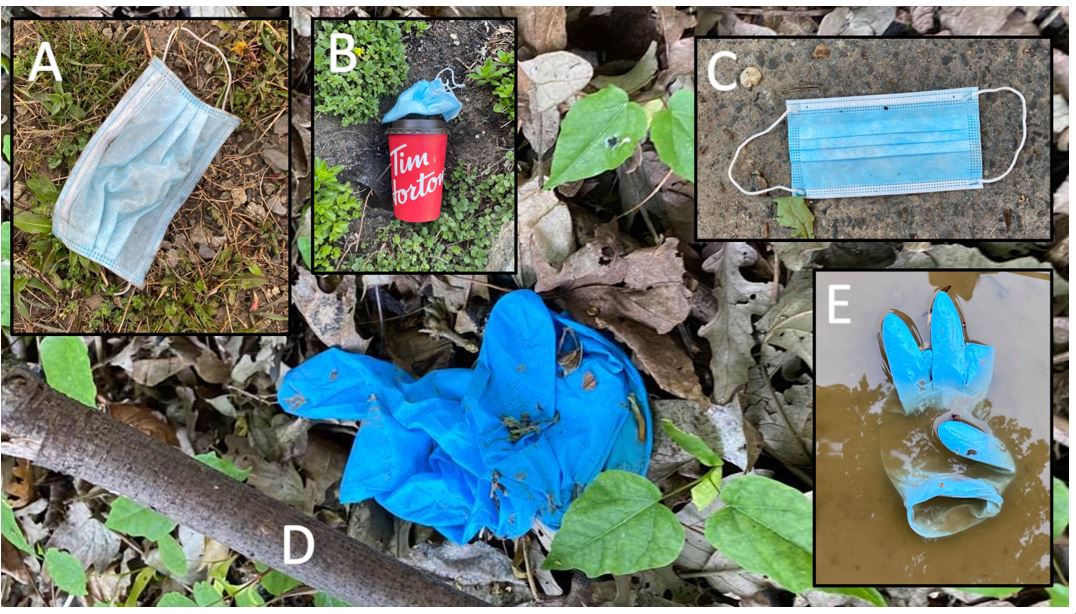Environmental Concern emerges from COVID-19 Pandemic: PPE Waste by the Public
Author(s):
Justine Ammendolia
Jacquelyn Saturno
Shoshanah Jacobs

Personal protective equipment (PPE) protects frontline workers from infectious diseases. Made of plastic materials like nitrile, vinyl, and latex for disposable gloves and polypropylene and polyester for face masks, this equipment is usually incinerated at medical waste facilities where tightly regulated waste management protocols avoid environmental spillage.1 The COVID-19 pandemic has resulted in a high demand for PPE from the global medical community and the public, challenging our waste management systems unlike previous global pandemics like SARS (severe acute respiratory syndrome) in 2003 and the swine influenza virus (H1N1) in 2009 (Figure 1). This current high demand for PPE production and consumption by the public has resulted in unanticipated environmental impact in the form of improper disposal by the public.

Figure 1- COVID-19 related personal protective equipment (PPE) debris found in Toronto, Canada during March 2020: (A-C) disposal facemasks and, (D-E) disposal nitrile gloves.
The global rise in public demand for PPE is due to COVID-19 transmission concerns, since the virus can be easily transmitted by respiratory droplets and can remain active on surfaces such as plastic for up to 3 days. 2 The Centers for Disease Control and Prevention 3 in the United States and the Federal Government of Canada 4 requested that the public avoid using medical-grade PPE; recommending instead the use of washable fabric masks. Furthermore, the use of disposable gloves is not currently a public health recommendation when vigilant hand washing is sufficient.5 These alternatives not only reduce demand for medical grade PPE, but can also reduce improper disposal. Yet despite these official recommendations, there has been widespread public use and littering of single-use PPE. 6
Anecdotal observations reported by the media and individuals on social media platforms have highlighted cases of littering contributing to the mounting problem of environmental plastic pollution. This is concerning because past studies have shown that leakage in the form of environmental litter from the waste stream is estimated to occur at global proportions of approximately 2%.7 An example that has gained widespread social media attention has come from the environmental clean-up group Opération Mer Propre in France. Their footage depicts scuba divers finding PPE debris on the seafloor of the Mediterranean.8 Furthermore PPE is also being found upstream on riverbanks, adjacent to freshwater systems, in urban cities such as Toronto, Canada (Pers. Observ.)
Given the widespread public use of single-use PPE across the globe combined with the current climate of anxiety to be protected in public places, this rate of spillage into the environment can result in massive quantities of plastic pollution. As plastic pollution in the environment is already a global issue according to the UN,9 pollution from PPE is an unnecessary strain on an already overwhelming problem. Canada like many other countries is unequipped from a legislative and waste management perspective to deal with pollution mitigation resulting from sudden pandemic events, hence we make the following recommendations below.
To facilitate proper disposal of the rapidly growing volumes of PPE waste from the public, we recommend the following: (1) encourage the public to use reusable PPE that can be frequently disinfected by increasing access to fabric masks and washing agents; (2) develop proper PPE disposal practices, learn about the nuisances of PPE pathways and implement improved collection methods and; (3) raise widespread awareness on proper PPE disposal practices through targeted government promotion and education campaigns. In protecting ourselves against COVID-19, we should not jeopardize the integrity of environmental health and create a future dilemma in the form of plastic pollution from PPE consumption.
References and Notes
1. E.S. Windfeld, M.S.L. Brooks, J Environ Manage. 163, 98-108 (2015).
2. N. van Doremalen et al., N. Engl. J. Med. 382(16), 1564-1567. (2020).
3. Centers for Disease Control and Prevention, “Use of Cloth Face Coverings to Help Slow the Spread of Covid-19” (2020).
4. Government of Canada, “Non-medical masks and face coverings” (2020).
5. World Health Organization, “Rational use of personal protective equipment for coronavirus disease 2019 (COVID-19) and considerations during severe shortages” (2020).
6. J. Bowden, “Discarded PPE poses environmental threat, experts say,” The Hill (2020).
7. J.R. Jambeck et al., Science. 347(6223), 768-771. (2015).
8. The Observers France 24. “Sea clean-up in France shows pollution from Covid-19 pandemic.” (2020).
9. UNEP. “UNEP Year Book 2014 emerging issues update.” United Nations Environment Programme. (2014).

